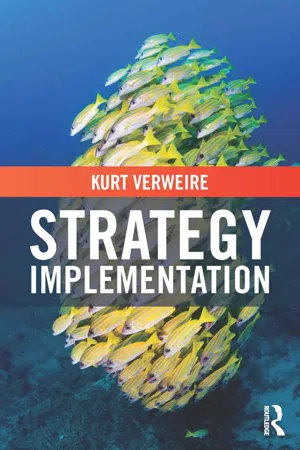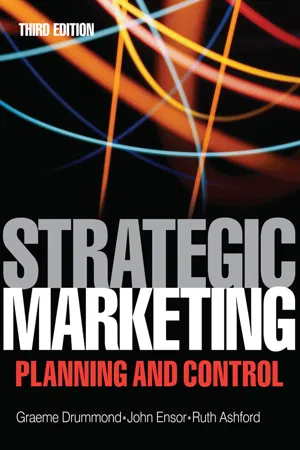Business
Strategic Implementation
Strategic implementation refers to the process of putting a company's chosen strategy into action. It involves translating high-level strategic goals into specific actions and initiatives that can be executed throughout the organization. Successful strategic implementation requires effective communication, resource allocation, and alignment of activities with the overall strategic direction.
Written by Perlego with AI-assistance
Related key terms
Related key terms
1 of 4
Related key terms
1 of 3
8 Key excerpts on "Strategic Implementation"
- eBook - ePub
- Kurt Verweire(Author)
- 2014(Publication Date)
- Routledge(Publisher)
3 Implementing a Winning Strategy Through Strategic Alignment DOI: 10.4324/9781315849447-4Strategy implementation is a stepchild in strategic management. Despite the significance of the topic, relatively little research attention has been given to it. However, Hamish Scott, a strategy professor from Ashridge Business School, rightly remarked that, ‘it is essential to remember that an organization moves forward only when something is done — until that point everything is just words’.1In this chapter, I will provide you with a new Strategy Implementation Framework and present some new ideas on effective strategy execution. Effective strategy execution is about aligning your organization’s activities around a common core theme, but it is also about creating the right organizational context, so that employees and managers are committed to making the strategy work. So, in essence, strategy implementation is about creating alignment and commitment. In this chapter, I will explain the concept of strategic alignment in detail. Before that, let’s take a closer look at what strategy implementation is.What is strategy implementation?
Intuitively, strategy implementation is a simple concept: it is about taking action in support of a strategy. It’s about translating the strategic choices into concrete actions to realize the organization’s strategic objectives. Academics define implementation as a process of several steps that involves committing resources, setting up organizational structures and control systems, and managing people to transform strategy into a concrete reality.2 However, that definition does not provide us with very concrete insights into how to tackle the strategy implementation challenge.In order to define what constitutes effective strategy implementation, I have looked at strategy implementation from a process perspective. An organization can be seen as interconnected sets of processes — and processes are a collection of tasks and activities that together transform inputs into outputs. Within organizations, inputs and outputs can be materials, information and people.3 I have identified five major sets of processes that managers must master to make strategy work. These are the five substantive levers you must pull to make strategy happen, and they constitute our Strategy Implementation Framework (see Figure 3.1 - eBook - ePub
- George Stonehouse, Bill Houston(Authors)
- 2003(Publication Date)
- Routledge(Publisher)
Chapter 10 Strategic Implementation
DOI: 10.4324/9780080476346-10Introduction and chapter overview
Strategic Implementation is all about what issues are considered to be necessary for the successful execution of strategy. In a prescriptive strategic process, Strategic Implementation would be carried out only after a company has gathered sufficient information on its internal and external environments (this being the purpose of strategic analysis) and after it has undertaken the process of strategy evaluation and selection (see Chapter 9 ).In order to successfully carry out a strategy, a company must consider several key areas. First, it must establish how the strategy will be resourced. Second, it should ask itself how well its current culture, structure and internal systems are able to meet the challenges of the strategy. Changes in any or all of these may become necessary. Finally, most strategies necessitate some degree of internal change and this process of change will need to be managed. This chapter discusses each of these matters in turn.Learning objectives
After studying this chapter, students should be able to:- describe where implementation fits into the strategic process;
- describe the role of resource planning in Strategic Implementation;
- explain how and why corporate culture plays an important part in implementation;
- understand the link between structure and strategy;
- describe the essentials of change management.
Implementation and the strategic process
Most people intuitively understand that a lot of information is required before any big decision is made. We wouldn't buy a house without a thorough survey and we would normally find out something about a company before we accepted a job with it. In the same way, a business would be risking a great deal if it were to pursue a strategic option without first carrying out a detailed analysis of its internal and external environments. - eBook - ePub
- Graeme Drummond, John Ensor, Ruth Ashford(Authors)
- 2010(Publication Date)
- Routledge(Publisher)
PART 3 Strategic Implementation
Passage contains an image
Strategic Implementation
DOI: 10.4324/9780080561219-13About this chapterImplementation is critical to the success or failure of any venture. Basic generic management principles (e.g. leadership, team building and delegation) contribute to the process. Marketing managers must evaluate the easy, or otherwise, of implementation and deploy project management techniques to achieve desired goals. Additionally, ‘internal marketing’ can ease the process of implementation.■ Implementation: stressing the importance
A key maxim in business is: never acquire a business you do not understand how to run. Equally, it would be true to say – never adopt a strategy you do not understand how to implement.It can be said that, in terms of strategy, planning is the easy part. With a basic grounding in marketing, most managers could sit down with a blank sheet of paper and develop an outline marketing plan. This plan may contain all the correct ‘buzz-words.’ Ideas relating to – market penetration, segmentation, globalization and competitive advantage would fill the page and a clear concise way forward formulated. However, it is not that simple. While many managers could produce such an outline – how many could implement it? Without implementation, the plan remains some ideas on a piece of paper.In the context of marketing the goal will be to achieve and/or maintain a marketing orientation: success by a process of understanding and meeting customer need. It is doubtful if a marketing strategy can be implemented where this orientation does not exist. Achieving such a view is dependent on the quality of management and their understanding of marketing as a business philosophy.It is reasonable to suggest that implementation is often a key determinant in the success or failure of any strategic activity. Therefore, it should be an integral part of any marketing strategy. This view is supported by examining the history of corporate strategy. Recent times have seen a move away from corporate planning to the concept of strategic management. The main difference is that strategic management addresses the issue of implementation. - eBook - ePub
The Strategic Planning Process
Understanding Strategy in Global Markets
- Marios Katsioloudes, Arpi K Abouhanian(Authors)
- 2016(Publication Date)
- Routledge(Publisher)
7 Implementing and executing strategies in the business and functional levelsLearning objectives:
After reading this chapter, readers will be able to: • Discuss the critical role of strategy implementation and execution as part of the strategic planning process model. • Recognize the importance of interrelationship between the different types of implementation tools to have successful strategy implementation and execution. • Explain the various aspects of organizational structure as a Strategic Implementation and execution variable. • Explain the various aspects of organizational culture as a Strategic Implementation and execution variable. • Recognize the role and influence of leadership on strategy implementation and execution.This chapter will focus on the part of the Strategic Planning Process (SPP) that involves implementing our strategic plans. Thus far, the concentration is largely upon the formulation of the plans themselves; merely mentioning that implementation and execution should be part of our considerations. Hopefully, going through the material in this chapter, you will begin to see why this part of the process is so important. In addressing these concerns, some material already discussed previously will be revisited in a somewhat different context, and we will introduce some new material.What is implementation/execution? Why are they so important?
As you might guess, strategy implementation is simply the set of activities and decisions necessary to turn the organization’s corporate and business strategies into reality. On the other hand, strategy execution is the set of decisions and activities undertaken to turn the implemented strategies into a commercial success that will grasp the best possible results.1 Like many definitions, this one is easy to state and remember, but its implications are deceptively far-reaching. What is the difference between implementation and execution? When Qatar’s Supreme Education Council issued a decree back in 2012 that, “Arabic should be the official teaching language at Qatar University,” this was part of the council’s strategy to preserve the country’s heritage and culture while preparing the nationals to take leadership positions in the competitive market.2 As a result, the University started to teach in Arabic language. Hence, this is strategy implementation. On the other hand, recruiting Arabic faculty members, translating the content of the courses to Arabic language, and preparing assessments in Arabic language are all part of strategy execution. Without the aforementioned activities, the results within the context of the implemented strategy would not be yielded.3 Just how important are - eBook - ePub
Strategy Journeys
A Guide to Effective Strategic Planning
- David Booth(Author)
- 2016(Publication Date)
- Routledge(Publisher)
This continual reference to the strategic plan helps make it as much a part of the organisation’s core work as its day-to-day operational activities. Indeed, undertaking those activities is a part of implementing the strategic plan, helping the organisation achieve its objectives. Conversations and actions demonstrate that it is important and reinforce commitment; interest, encouragement and thanks impart energy. A strategic plan that is at the heart of an organisation, that becomes a strategy journey being undertaken by everyone in the organisation, is going to be much more effective than a document that sits on a shelf, however many boxes it ticked when it was produced.Strategic management
How do you measure progress when implementing a strategic plan? Here are two examples to illustrate alternative ways of approaching this:The development process of Organisation M’s strategic plan is complete; a document summarising it has been produced (with versions adapted to various stakeholder audiences), and in-depth discussions about it have occurred throughout the organisation. The focus is now on carrying forward the momentum of the past few months into setting up the implementation phase, with a strong commitment to making the plan happen and a determination that this organisation’s strategic plan will not founder during implementation.A robust governance structure has been established, with a programme team coordinating the various strategic initiative workstreams, steering groups with board-level representation and cross-functional project teams already formed and starting to meet. The executive team has brought in programme management expertise to assist with project coordination and reporting. The project groups consider their briefs and work out how they will approach this and go about their tasks. There is some discussion about clarification, and in some cases the scope was changed to include aspects that had not been considered initially. Project plans and Gantt charts have been developed and published, and the work begins. - Darren Dalcher(Author)
- 2018(Publication Date)
- Routledge(Publisher)
Aligning strategic themes with short-term project and programme initiatives requires periodic review of progress. Strategic-theme owners need oversight over the entire portfolio of action to ensure that all initiatives are progressing and the resulting actions deliver meaningful results.British politician and prime minister Sir Winston Churchill wryly noted, ‘However beautiful the strategy, you should occasionally look at the results.’Delivering strategic initiatives, successfully, requires effective alignment, integration and active engagement across business units, strategic themes, interest groups and funding arrangements. It also implies understanding the role of change in the context of the wider business whilst making transformational progress visible across lines, units and boundaries. Yet, above all, perhaps it requires a deeper conversation about what it takes to implement and deliver in a strategic context, acknowledging, as Kaplan and Norton ultimately did, that initiatives can not be executed in isolated silos without looking at the wider implications. And that is why we really do need to talk about strategy.References
Brache, A. P. & Bodley-Scott, S. (2006). Implementation: How to transform strategic initiatives into blockbuster results. New York: McGraw Hill Professional.Kaplan, R. S. & Norton, D. P. (2008). The execution premium: Linking strategy to operations for competitive advantage. Boston, MA: Harvard Business Press.Passage contains an image
MANAGING STRATEGIC INITIATIVESTerry Cooke-DaviesIntroduction
It is commonplace to hear the word ‘strategy’ used in conversations between executives, managers and staff when the topic of an organisation’s intentions, aims and objectives are being discussed. Similarly, organisations’ leaders are prone to launch ‘initiatives’ that are designed to change something about the business, to help implement its ‘strategy’. Such ‘strategic initiatives’, therefore, are highly likely to consist of work that can best be viewed as projects, programmes or collections of projects and programmes.- eBook - ePub
Creating Your Strategic Plan
A Workbook for Public and Nonprofit Organizations
- John M. Bryson, Farnum K. Alston(Authors)
- 2015(Publication Date)
- Jossey-Bass(Publisher)
39 ), and Step 7, on plan review and adoption, a number of factors likely to dramatically affect implementation success should have been considered. For example:- Having or building the necessary political will and external and internal support to make desirable changes
- Having the ability to commit the resources necessary to implement the plan in its entirety, or at least critical parts of it
- Being able to focus on what are agreed to be the highest priorities, or to have a strategy for making sure the highest priorities receive timely attention
- Finding ways to motivate key personnel to change, including aligning incentives appropriately
- Developing ways to change the organizational culture and belief system in desired directions
- Making necessary changes in organizational structures and processes
- Being able to make necessary changes in mandates
As implementation is planned and pursued, each of these items will become the focus for dialogue and deliberation. In other words, the dialogue and deliberation that are at the heart of strategic planning should continue throughout the implementation process, so that strategic thinking, acting, and learning are continuously fostered and the organization is helped to fulfill its mission, meet its mandates, realize its vision, and achieve its goals and objectives.Furthermore, it also bears repeating that implementation does not need to wait until the strategic plan is done. Whenever wise implementing actions can be taken, they should be. Targeting “low-hanging fruit” and small wins for early action is a way of showing that things are going to change as a result of the time, effort, and resources expended on the planning process, and it will also build ongoing support for the process and make the more full-blown implementation effort easier. - eBook - ePub
From Logistics Strategy to Macrologistics
Imperatives for a Developing World
- Jan Havenga, Ilse Witthöft, Anneke de Bod, Zane Simpson(Authors)
- 2020(Publication Date)
- Kogan Page(Publisher)
Leaders have the ability to communicate and convince subordinates that the strategy the organization is embarking on is important for the future of the organization. The leader needs to guide the consensus and mutual understanding process of employees. Many business and executive training courses concentrate on strategy formulation, and not necessarily implementation (Shirey, 2011). In addition, the perception exists among some top-level managers that strategy implementation is ‘beneath them’ and lower-level operational staff need to do it (Hrebiniak, 2005).Keeping employees committed and motivated to strategy implementation, as well as the development of down-the-line leadership skills, are core functions of leadership (Rajasekar, 2014; Beer and Eisenstat, 2000). Leadership should not assume that the rest of the organization has the same understanding of the strategy and implementation actions; they should assume they do not and then influence, motivate, communicate and guide them through the process.Gattorna et al (1991) emphasized the imperative of aligning the organization (leadership and culture) with the strategy being implemented, which is in turn aligned with customer needs (market). This framework evolved into the dynamic alignment framework depicted in Figure 8.2 (Gattorna, 2010).Gattorna, 2010Figure 8.2 Dynamic alignment frameworkFigure 8.2 details ‘Human performance’ is shown to include the following:- Culture: Internal capabilities
- Leadership style: Shaping and creating
- Marketplace: Rules
- Strategy: Playing the game
This dynamic alignment is key to the success of the organization. Gattorna’s work highlighted that, in the past, supply chains were typically seen as a 50/50 mix of infrastructure and information system technology while, to implement successful value chain management, the human aspect is imperative. He proposes a 45/45/10 mix – human behaviour, systems technology and asset infrastructure – to enable the dynamic alignment framework.
Index pages curate the most relevant extracts from our library of academic textbooks. They’ve been created using an in-house natural language model (NLM), each adding context and meaning to key research topics.
Explore more topic indexes
Explore more topic indexes
1 of 6
Explore more topic indexes
1 of 4







